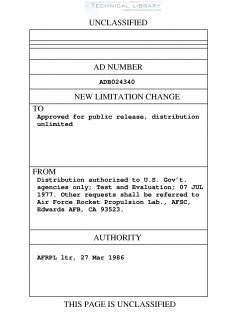AFRPL-TR-77-49
- Version
- 271 Downloads
- 6.15 MB File Size
- 1 File Count
- March 1, 2017 Create Date
- March 1, 2017 Last Updated
Improved Jet Tab Thrust Vector Control for the BGM-34C Booster

Thrust vector control (TVC) has been detemined to be a requi renent for the ground launching of a large remotely piloted vehicle (RPV) . The ground launch of small RPV's had previously been demnstrated without TVC, but required precise and difficult to achieve system alignments prior to lift off. In a tactical situation, the possibility of asymmetrical external loads, CG shift during turbojet run up and irregular terrain for launcher munting dictated a T VC capability to assure a successful launch. The jet tab TVC system was selected for the JBQM-34H ground launch program as the lowest risk approach to integrating a T VC system into an existing solid rocket nntor. The jet tab T VC was especially attractive because of the basic fixed nozzle system and its electrical actuation system which used excess on-board power. The existing sol id motor exit cone was installed at a threaded interface just aft of the nozzle throat. By replacing the simple exit cone with a jet tab system, no changes in the solid nntor were needed and a minimal risk program could be accompl ished. det tab thrust vector control (TVC) system development by TRW with the Air Force Rocket Propulsion Laboratory (AFRPL) began in March 1970 with Contract F04611-70-C-0060, The feasibility Of the concept was successfully deronstrated under contra-t and development was continued in March 1971 under Contract F04611-71-C-0036 to extend the capabilities of the jet tab system to the high chamber pressure and highly aluminized propellant environ- ments. uring those two prograns, 18 test firings were conducted during which the jet tab TVC system demnstrated: up to fourteen degrees thrust vector deflection. Structural integrity with total tab exposure time greater than 20 seconds. Repeatable thrust vector performance with propellant aiuminum loadings up to 21.1 percent and mtor chanter pressures to 2600 psi. Actuation torques well within the range for small electric notors.
| File | Action |
|---|---|
| AFRPL-TR-77-49 Improved Jet Tab Thrust Vector Control for the BGM-34C Booster.pdf | Download |

Comment On This Post